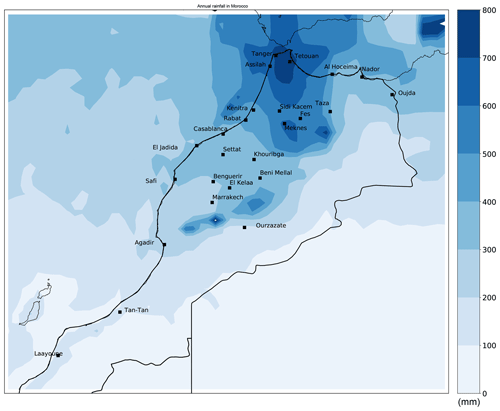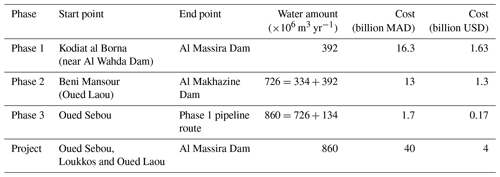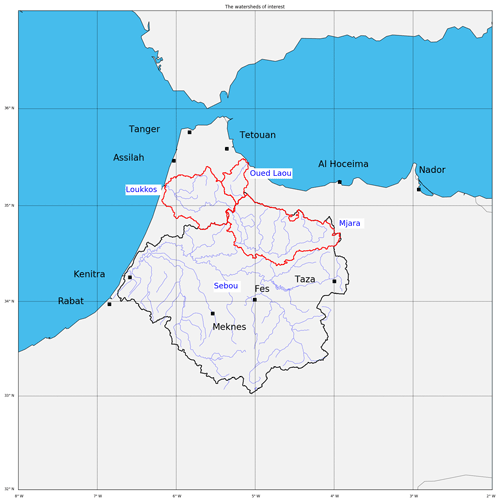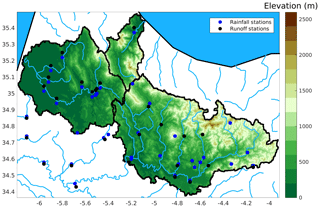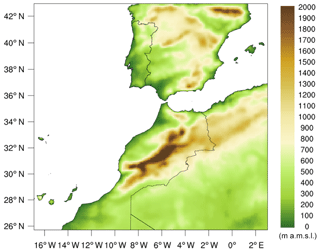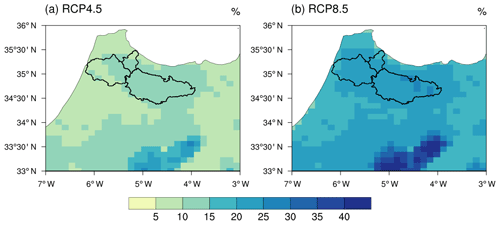the Creative Commons Attribution 4.0 License.
the Creative Commons Attribution 4.0 License.
Climate change impacts on the Water Highway project in Morocco
Suchul Kang
Elfatih A. B. Eltahir
The hydrology of Morocco is characterized by significant spatial variability. Precipitation follows a sharp gradient, decreasing from the north to the south. In order to redistribute the available water, a project has been proposed to transfer 860×106 m3 yr−1 from the wet north to the arid southern regions, namely the “Water Highway” project. The present study aims to address the viability of the project after accounting for the impacts of climate change in the watersheds located in the north. We perform regional climate model (RCM) simulations over the study region using boundary conditions from five different global circulation models (GCMs) and assuming two different emissions scenarios – RCP4.5 (with mitigation) and RCP8.5 (business as usual). The impact on precipitation and temperature are assessed, and the decrease in the available water quantity is estimated. Under RCP8.5, the project is likely not feasible. However, under the RCP4.5, a rescaled version of this project may be feasible depending on how much water is allocated to satisfy the local water demand in the north.
- Article
(4137 KB) - Full-text XML
- BibTeX
- EndNote
In many regions in the world, water scarcity is a critical issue that should be seriously addressed by stakeholders. Greve et al. (2018) define water scarcity as the ratio between the natural water supply and the local water demand. As a result, water scarcity mainly depends on two factors: hydro-climatology and the socioeconomic situation (Wada et al., 2014). While a study has shown that Morocco is not really threatened due to population growth (Boke-Olén et al., 2017), several studies have suggested that arid and semiarid regions like Morocco should develop new policy in order to adapt to climate change (Kahil et al., 2015; Batisani and Yarnal, 2010; Lioubimtseva and Henebry, 2009). As reported by Greve et al. (2018), different policies could be adopted, including investments in structures for transferring water from one basin to another.
Hydrology in Morocco is characterized by strong spatial and temporal variability (Driouech et al., 2010; Tramblay et al., 2013). This uneven distribution of water has led the Moroccan government to develop hydraulic infrastructure to improve the local management of water resources throughout the country. In 1967, King Hassan II launched a project to irrigate 1×106 ha by the year 2000. More precisely, the plan was to build a dam every year. The outcomes of this strategy helped to achieve food security, increase cash crop production for export, and improve the social and economic level of local farmers. More implicitly the construction of these infrastructures has helped communities to adapt to climate variability. Previous studies (Doukkali, 2005) have shown that although these efforts resulted in the significant optimization of water resource management in Morocco, they remain insufficient to ensure water and food security. A new policy is needed to complement these efforts. By 2020, only the watersheds in the north of Morocco will have a water excess compared with the demand (Minoia and Brusarosco, 2006). The proposed north–south water transfer project (Water Highway) aims to supply water to the arid southern regions from the watersheds in the north (see Fig. 2). The projected quantity of water to be transferred by this project is 860×106 m3 yr−1 (Water-Office, 2017).
Other countries have adopted similar policies in order to alleviate water scarcity problems. In China (Gu et al., 2012), water is transferred from the tropical southern region to the very dense, industrialized, arid north as a result of the South–North Water Transfer Project (SNWTP). The goal of this project is to transfer 44.5 km3 yr−1 from the Yangtze River basin. Although the economic benefit of the project is appreciated in the region (Feng et al., 2007), it has raised some controversy (Berkoff, 2003). First, transferring water in open channels increases the risk of pollution (Tang et al., 2014). Traffic accidents, especially those involving trucks, represent a threat to water quality. Moreover, the risk of the salinization of both basins (due to the transfer of salts in the receiving basin and due to sea water intrusion in the source basin) has been highlighted by Zhang (2009). Therefore, significant efforts need to be made in order to improve watersheds' management (Zhang et al., 2009). The Water Highway project could also lead to a dramatic increase in the water cost. These concerns have been raised with respect to the SNWTP in China by two studies (Wei et al., 2010; Yang and Zehnder, 2005). In fact, the SNWTP relies significantly on the water availability in the south of China, and, as has been suggested by Liu and Zheng (2002) and Li et al. (2015), the water quantity will decrease in the donor watersheds due to global climate change. However, this decrease will not affect the viability of the project in the China. In contrast, it is not clear if the change in precipitation would impact the viability of the project in Morocco. Therefore, the goal of the present study is to assess the viability of the Water Highway, including the impact of climate change.
Global change is impacting the African climate. Indeed, many studies have shown that the regional climate of Africa is likely to change during the upcoming decades (Sowers et al., 2011). This change is expected to have considerable socioeconomic and environmental impacts. A recent study that used the IPCC AR4 (Fourth Assessment Report of the Intergovernmental Panel on Climate Change) emission scenarios to predict climate change in Africa reported that the northern part is more likely to suffer from an increase in temperature and a decrease in the amount and frequency of precipitation (Vizy and Cook, 2012). As a result, North Africa will be vulnerable to climate change (Döll, 2009).
Over the last few decades, Morocco has built one of the strongest economies in Africa (USD 101 billion in gross domestic product, GDP, as reported by the World Bank, https://data.worldbank.org/country/morocco, last access: 20 March 2020), although this economy, however efficient compared to other developing countries, depends significantly on water availability (agriculture represents 15 % of the GDP). Water imbalance between supply and demand is growing (Hellegers et al., 2013). In Morocco, water demand is affecting water scarcity more intensely than climate change (Vörösmarty et al., 2000). On the one hand, the urban population is expected to increase by about 270 thousand inhabitants per year due to urbanization, as reported by the Moroccan High Commission for Planning website (http://www.hcp.ma/, last access: 5 March 2019). On the other hand, improved irrigation schemes have certainly intensified cash crop production in Morocco, but they have also increased the water demand. Indeed, Ward and Pulido-Velazquez (2008) show that the increase in efficiency increases water use. Furthermore, climate change projections predict that Morocco will experience a dry future (Giorgi and Lionello, 2008; Kang et al., 2020) and a decrease in precipitation (Patricola and Cook, 2010). For all of the abovementioned reasons, among others, the country is becoming increasingly vulnerable to global change; therefore, adaptation policies are a required for the development of the country under such conditions (Schilling et al., 2012).
The purpose of the present work is to study the viability of the north–south water transfer project, considering the impact of climate change. More precisely, the study aims to assess the effect of climate change on water availability in the northern basins. In order to evaluate the impact of climate change on this project, multi-model climate simulations were performed. Forcing boundary conditions from five global circulation models (GCMs), including MPI, GFDL, IPSL, CSM and ACCESS, were considered in order to quantify the uncertainty in future climate projections (Tebaldi and Knutti, 2007). The simulations were performed using MRCM (MIT Regional Climate Model) and plausibly recreated the impact of global change on precipitation and temperature (Eltahir et al., 2013). We choose to assess the impact of climate change for a 30-year duration for two main reasons. The first motive is linked to climate change; in fact, this project has been designed in order to face future climate change impacts on southern Moroccan areas. If the project could potentially jeopardize the water security of the northern region, how can it also satisfy the southern region's water demand? The second reason is purely from a feasibility perspective. The project will take more than 10 years to fully construct, not to mention that the project has not started yet (construction was planned to start in 2018). In addition, the Moroccan government has only made the budget for the first phase available. The second and the third phases are still waiting on the necessary funds, which will certainly delay the project for another 10 years. The impact on runoff and, in turn, on water availability is assessed using the runoff elasticity (Sankarasubramanian and Vogel, 2003; Tang and Lettenmaier, 2012) based on available data and RCM simulations. Such methodology can be used to evaluate the impact of climate change on water availability in regions where hydrological modeling may not be feasible. We confronted the results of our work with other published works on the assessment of the impact of climate change on water availability in the region.
The article is presented as follows: Sect. 2 describes the north–south water transfer project in Morocco, the northern region that ought to supply water to the arid regions in the south and the available datasets needed to perform the analysis. Section 3 is dedicated to presenting the methodologies used in order to assess the expected loss of water in the northern watersheds. Finally, Sect. 4 presents the results, and the conclusions and perspectives are described in Sect. 5.
2.1 Water distribution in Morocco
Morocco is located in the northwest of Africa. Given the country's geographical position, the climate is characterized by strong spatial variability. Indeed the southern part of the country is affected by the extreme dry climate of the Sahara Desert, and the northwestern part benefits from the moderate climate of the Mediterranean Sea and Atlantic Ocean. In addition, the topography of Morocco also varies in space. The coastal region is flat, whereas the topography is shaped by the Rif Mountains and Atlas Mountains in the north and the east, respectively. Therefore, the climate can vary from subhumid to arid over the country (Born et al., 2008). As a result, the precipitation over Morocco varies strongly in space. Figure 1 displays the annual mean precipitation over Morocco using TRMM (Tropical Rainfall Measuring Mission) data (Huffman and Bolvin, 2013). The annual precipitation reaches 800 mm yr−1 in the north, whereas the south barely receives 100 mm yr−1. As a result, only the extreme northwestern part of the country enjoys an excess water supply.
2.2 The general features of the project
As reported by the Moroccan department in charge of water, plans are ready to launch the north–south water transfer project (Water-Office, 2017). The water balance analysis prepared in the studies carried out by the Moroccan Department of Water shows that southern basins, notably the Tensift and Oum Er-Rbia, are in deficit. In contrast, the northern basins discharge excess water to the sea. A transfer from the northern basins, which are much better equipped with respect to hydraulic structures, would relieve these deficits and consolidate national water management integration. The preliminary pre-feasibility studies conducted by the Moroccan Department of Water have shown that roughly 860×106 m3 yr−1 could be transferred on average from the Oued Laou, Loukkos and Mjara basins (see Fig. 3) to the Bouregreg, Oum Er-Rbia and Tensift basins (see Fig. 2). The project implementation schedule as well as the institutional and financial setup will be defined by the studies in progress by both of the ministerial departments concerned, namely water and agriculture.
The project, following three phases as described in Table 1, will involve the construction of nine pumping stations,two new dams, and 500 km of channels and pipes to transfer water from Oued Laou, Loukkos and Sebou to Al Massira Dam.
2.3 Description of watersheds of interest
The purpose of this study is to analyze the effect of climate change on the project. In order to address the viability of the project, the global climate change impact on the hydrology of the donor watersheds needs to be assessed. Figure 3 presents the three watersheds that will supply the project, namely Loukkos, Oued Laou and Mjara (presented using a red contour). The latter is a sub-watershed of the Sebou watershed, supplying most of the Sebou water. The three water basins are located in the northern region of Morocco, where the precipitation levels are relatively high. There is a spatial gradient of elevation from the northeast to the southwest due to the presence of Rif Mountains (see Fig. 4).
3.1 Datasets
In order to perform this study, we accessed several datasets. Table 2 summarizes the available data. Each dataset is available at a monthly time step.
3.1.1 Spatial data
Spatial data help to understand the temporal as well as the spatial variability of precipitation. For the present case, we use the data from the space mission TRMM (Tropical Rainfall Measurement Mission) (Huffman and Bolvin, 2013). We also downloaded remote sensing data specifically for the region of Morocco and extracted it for the three watersheds considered in this analysis.
3.1.2 Gauge station data
Gauging station data were also used. The sources of the data used here are the respective river basin agencies of Sebou and Loukkos. In Morocco, river basin agencies (ABH “Agence du bassin hydraulique”) are in charge of the evaluation, the planning and the general management of water resources within a watershed. In our case, the Mjara watershed is managed by ABH Sebou (shown using a black contour in Fig. 3). For this watershed, 17 rainfall stations and 24 runoff stations are available. Loukkos and Oued Laou, in comparison, are managed by ABH Loukkos. This agency made 11 rainfall and runoff stations available for the purpose of this study. All of the gauge stations used in this study are displayed in Fig. 4.
These data have the advantage of being more accurate than the spatial data, but they are more likely to include missing values. In order to use them, one method of filling the missing values (∼5 %–10 %) is to replace them with their long-term mean. There are other methods that can also be used to fill the missing values, but only the abovementioned method will be used in this study, as it seemed accurate enough for our purposes.
3.2 Regional climate modeling
The present study used the MIT Regional Climate Model (MRCM), which is based on the ICTP Regional Climate Model Version 3 (RegCM3, Pal et al., 2007) but includes several improvements. A detailed description of the MRCM is given by Im et al. (2014a). There are substantial differences between MRCM and RegCM3. In particular, based on the simulations using MRCM-IBIS over the West Africa, the use of IBIS as the land surface scheme results in the better representation of surface energy and water budgets in comparison with RegCM3-BATS. Furthermore, the addition of a new irrigation scheme in IBIS makes it possible to investigate the effects of irrigation over West Africa (Im et al., 2014b; Alter et al., 2015).
Building on the good performance of MRCM in previous studies, we project multi-model ensemble regional climate change using this model to advance our understanding of the future conditions in response to anthropogenic GHGs (greenhouse gases) over Morocco. To achieve this, a total of fifteen 31-year projections under multi-GCM (IPSL-CM5A-LR, GFDL-ESM2M, CCSM4, MPI-ESM-MR and ACCESS1.0; see Table 3) and multiple emission scenario (Historical, RCP4.5 and RCP8.5) situations are dynamically downscaled using MRCM with a 12 km horizontal resolution over Morocco (Fig. 5). The first year of MRCM simulations in both the baseline and future periods is used for model spin-up and has been discarded in the analysis. Five GCMs are selected based on a rigorous evaluation (NRMSE, normalized root-mean-square error; PCC, pattern correlation coefficient; and annual cycle) of their performance with respect to simulating regional climate over Morocco, while RCP4.5 and RCP8.5 represent mitigation and business-as-usual scenarios, respectively. We refer the reader to the companion paper (Kang et al., 2020) for a detailed discussion of the RCM simulations and model performance.
Bi et al. (2013)Gent et al. (2011)Dunne et al. (2012)Dufresne et al. (2013)Giorgetta et al. (2013)3.3 Runoff elasticity
The issue of the sensitivity of runoff to climate change has been investigated in different studies. There are several methodologies to address this issue as reported by Sankarasubramanian et al. (2001). One of the most common approaches is the use of a calibrated hydrological model. Then, with the help of RCM simulations of future climate, one is able to study the sensitivity of runoff. The major difficulty involved in this method lies in the calibration of model parameters from a finite set of observations. One assumes that the parameters' values do not change through time. This assumption has been extensively discussed in the community, and several studies have demonstrated the importance of a dynamical correction of model parameters (Reichle et al., 2002; Moradkhani et al., 2005).
Another approach is the application of simple water balance models and to analytically derive the elasticity coefficient. One could also explain the sensitivity of runoff to all climatic variables as in Yang and Yang (2011). Indeed, this study concludes that the hydrological cycle is influenced by climatic variables other than precipitation and temperature and computes runoff sensitivity to net radiation and wind speed at a height of 2 m above the ground. In contrast, following the Budyko hypothesis, the long-term mean runoff is mainly driven by the long-term mean of precipitation and the potential evapotranspiration rate. Therefore, runoff elasticity coefficient should be an explicit function of precipitation and the potential evapotranspiration rate. Following this idea, different studies have developed empirical relationships (Schreiber, 1904; Ol'Dekop, 1911; Turc, 1953; Pike, 1964; Zhang et al., 2001). Niemann and Eltahir (2005) demonstrated that the estimation of the runoff elasticity coefficient with these analytical formulas is consistent with the coefficient calculated from a physically based hydrological model (Niemann and Eltahir, 2004).
Another method of deriving the runoff sensitivity to climate change is the use of observational datasets. One is able to examine how runoff changes as climatic variables change. This assumes that the response of annual runoff to the variability in annual climatic forcing is the same as the response of the long-term mean runoff to the changes in the long-term mean climatic variables. This approach has been tested in Risbey and Entekhabi (1996) and Sankarasubramanian et al. (2001). The first study showed that Sacremento River runoff is insensitive to changes in temperature, while it is more sensitive to precipitation. In the second study, the authors used a similar methodology in the major rivers in the US. They showed that when the rivers are located in dry areas, the sensitivity of runoff is mostly explained by precipitation. However, when the rivers are located in areas with an important contribution from snowpacks to the water balance, runoff is less sensitive to precipitation.
In the present study, as we lack sufficient data to develop a well-calibrated hydrological model, we choose to evaluate the potential change in runoff using the last two approaches described above. First, we evaluate the potential change in runoff using empirical equations first defined by Dooge et al. (1999) and Arora (2002). Following these studies, the long-term change in runoff is mainly driven by the long-term change in precipitation and the long-term change in potential evapotranspiration (PET). Therefore, this can be expressed as follows:
where , and are long-term normalized changes in runoff, precipitation and potential evapotranspiration, respectively. Consequently, the evaluation of runoff sensitivity to climate change requires the estimation of ϵ (the runoff sensitivity to precipitation) and ϵPET (the runoff sensitivity to PET). In Arora (2002) and Yang and Yang (2011) these coefficients are computed using empirical equations:
where . Therefore, the estimation of the runoff sensitivity coefficients are a function of the aridity index ϕ and the mathematical function F(ϕ) that relates the runoff ratio to precipitation (or PET) to the aridity index. These functions have been defined as empirical relations in different studies. Although these formulas have been developed to find the ratio of the evapotranspiration rate to the potential evapotranspiration rate, they could be rearranged to utilize runoff sensitivity to climate change as in Niemann and Eltahir (2005) and Yang and Yang (2011) (see Table 4).
Schreiber (1904)Ol'Dekop (1911)Turc (1953)Pike (1964)Zhang (2009)Table 4Mathematical form of F′(ϕ), where ϕ refers to the aridity index, and F(ϕ) is a mathematical function relating the runoff ratio to precipitation (or PET) to the aridity index.
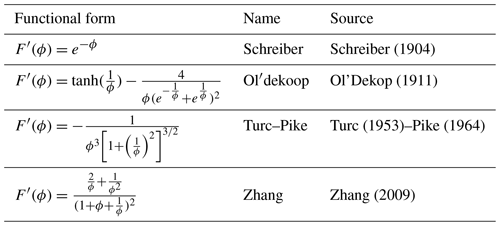
In the present work, we compare the results from different empirical relationships. The long-term change in precipitation is estimated using RCMs (regional climate model) simulations, and the long-term change in potential evapotranspiration is derived from the Penman–Monteith equation (Monteith, 1965) and using RCM simulation results. This method is preferred over the Thornthwaite equation (Thornthwaite and Mather, 1957) for the reasons described in Yang et al. (2017).
The second approach utilized here is to evaluate the changes in runoff as a result of climate change using data analysis. The sensitivity of runoff to climate change is computed via the runoff elasticity coefficient. First we use the definition given by Yang and Yang (2011) and references therein. The runoff elasticity, ϵ(Q), is defined as the fractional change in runoff, Q, due to a fractional change in precipitation, P, as shown in the following equation:
In the present case, the estimation is carried out with the following parameters: is the annual mean precipitation, is the annual mean runoff and is estimated using linear regression.
3.4 Presentation of study areas
3.4.1 Loukkos
The Loukkos watershed is one of the wettest regions in Morocco. The annual precipitation is around 790 mm, and the hydrological regime is characterized by a wet winter and a dry summer with a precipitation maximum during November and/or December (see Fig. 6a). However, precipitation in the region varies significantly from year to year. The annual precipitation can reach 1400 mm in some years (see Fig. 6b). Indeed, the coefficient of variation of annual precipitation computed using the ABH Loukkos data is 28 %. Given this variability, water resource management is a challenging task.

Figure 6The hydrology of the Loukkos watershed. (a) Interannual variability of precipitation and comparison with TRMM. (b) Monthly variability of precipitation. (c) Annual precipitation vs. annual runoff.
The strong interannual variability in precipitation leads to a strong interannual variability in runoff (see Fig. 6c). The pattern of runoff is similar to that of precipitation. The annual mean runoff is 1 km3 yr−1. Given its topography, this watershed represents a good site for Morocco to store water. However, this region lacks the infrastructure needed to store water and to optimize water resource management.
3.4.2 Oued Laou
The Oued Laou watershed is the smallest watershed considered in this analysis. However, due to its geographical position, the region receives a large amount of precipitation compared with other areas in the country. The annual mean precipitation is about 740 mm, which represents a large quantity of water falling over a relatively small area (919 km2). However, the variability in the precipitation received is tremendous, as shown by the coefficient of variation of 43 % (see Fig. 7), which makes forecasting water availability very difficult. Figure 7c presents the variability in the runoff and precipitation over Oued Laou. The variability of runoff seems to follow that of precipitation. The annual mean runoff in Oued Laou is 0.4 km3.

Figure 7The hydrology of the Oued Laou watershed. (a) Interannual variability of precipitation and comparison with TRMM. (b) Monthly variability of precipitation. (c) Annual precipitation vs. annual runoff.
3.4.3 Mjara
The hydrology in Mjara is also characterized by significant monthly variability. The annual mean precipitation is 655 mm, and the coefficient of variation is about 43 %. Thanks to the gauge station at Mjara, we were able to estimate runoff. As seen in Fig. 8c, the variability in water availability at Mjara follows the variability in precipitation. This statement is especially true during drought years, such as those that Morocco experienced during the 1990s, when the variability of runoff follows that of precipitation very tightly. All in all, the annual average runoff from Mjara, which is considered to be the wettest region in Morocco and is the location of the largest (namely Al Wahda) dam in the country, is 3 km3 yr−1.
4.1 Future changes in precipitation
In order to assess the impact of climate change on water availability, we have performed numerical simulations (Kang et al., 2020), as described in Sect. 3.2. Overall, the resulting simulations forced by the five GCMs agree that precipitation will decrease in the future in the region of interest. However, depending on the boundary conditions and the scenario considered, the magnitude of the decrease differs. All of these results are summarized in Table 5. There is a large uncertainty regarding the amount of precipitation in the future in the study region. As has been shown in earlier studies (Déqué et al., 2007), the largest source of uncertainties in RCM simulations is boundary condition forcing. This would explain the difference in results in our case when we change the forcing GCMs, even for the same scenario. However, for fixed boundary conditions and the same scenario, the level of precipitation decrease is similar over the three watersheds. Following RCP4.5, the minimum decrease is simulated when the forcing GCM is CCSM: the estimated amount of change is roughly −10 %. The maximum decrease is simulated when the model is forced with ACCESS: the amount is roughly equal to −35 %. As a result, following RCP4.5, the projected precipitation change is between −35 % and −10 % for this region. In contrast, following RCP8.5, the minimum decrease is achieved when the boundary conditions are described by MPI and is roughly equal to −33 %; however, the maximum decrease is simulated when the RCM is forced by IPSL and is estimated to be around −7 0%. As a result, if the future is driven by RCP8.5, precipitation is expected to decrease by 33 % in the best-case scenario and by 70 % in the worst-case scenario. On average, following RCP4.5, precipitation is going to decrease by 24 %, whereas under the scenario RCP8.5, the decrease would be 47 %. To summarize, precipitation is likely going to decrease in the future for this region; however, the magnitude of the decrease is uncertain. Nevertheless, the range of uncertainty has been quantified.
Table 5A summary of the potential changes in precipitation following the RCP4.5 and RCP8.5 simulations with MRCM for the five different GCMs' forcing.
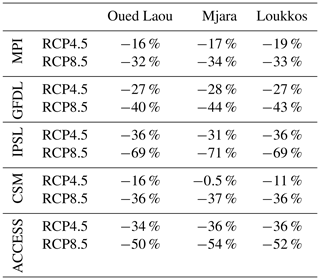
These simulations results concur reasonably well with those from other studies (Patricola and Cook, 2010; Droogers et al., 2012; Marchane et al., 2017). For example, Tramblay et al. (2018) adopted a multi-model simulation strategy using different RCMs with a high resolution (12 km) to assess the climate change impact on water resources in the Maghreb region. Simulations converge towards a decrease in precipitation over Morocco; however, the amount of the decrease is subject to a similar uncertainty as that demonstrated in our simulations. The decrease in precipitation is generally manifested by a decrease in rainy days and the intensity of precipitation (Tramblay et al., 2013). Nonetheless, the occurrence of heavy rain events is identified as the main uncertainty (Filahi et al., 2017).
4.2 Future changes in runoff
4.2.1 Using data analysis
The first approach used here to assess the climate change impact on water availability is the estimation of the runoff elasticity coefficient via the analysis of available data. We follow the definition described in Sect. 3.3. The objective is to estimate the potential loss of water that would result from the decrease in precipitation using available precipitation and runoff data over each watershed. We assume that the relationship between precipitation and runoff is well represented by past data. This relationship is first described by the slope of the runoff–precipitation relationship as documented in observations (see Fig. 9). We then normalize this relationship by dividing by the ratio of long-term runoff to long-term precipitation.
For the specific case of Oued Laou, only one precipitation gauge station is present. In order to alleviate bias creation in the calculation of the elasticity coefficient, we use TRMM observations. Figure 9 shows the estimation of the runoff elasticity coefficient for the study region. The three watersheds seem to behave in the same manner when forced by precipitation variability. In general, the elasticity coefficient is around 1.6; thus, a change of 10 % in precipitation would lead to 16 % change in runoff. When using linear regression, the uncertainty range could be quantified. In the present case, a confidence range was added to the elasticity value, as presented in Table 6. The uncertainty range is large for Oued Laou due to the complex topography of this very small watershed. Mjara and Loukkos have the same range of uncertainty.
Table 6Elasticity of the runoff to precipitation estimation and quantification of the uncertainty compared with the analytical formulas given in Table 4.
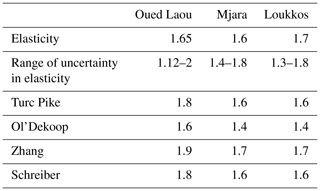
Based on the calculation of the runoff elasticity coefficients and given the projected decrease in precipitation described in the previous section, we are able to estimate the potential total available water in the three watersheds in the future. Table 7 summarizes the results. As a metric of the vulnerability of water availability in the region impacted by the project, we show the ratio of the total amount of water to be transferred (0.86 km3 yr−1) to the total available water. In the current climate, about 20 % of the total available water is allocated to the Water Highway based on the initial design. On average, following the RCP4.5 projection, it is expected that only 40 % of the actual available water will be lost in the future compared with the current climate. As a result, 33 % of the available water will be allocated to the project if the design remains the same as in the current climate.
Table 7A summary of the expected loss of water in the three watersheds, and how the project will affect water availability. We assume the current project design of transferring 0.86 km3 yr−1. The available water refers to how much water is available in the whole study region. () is the ratio of the amount of water that will be allocated to the project, if the project remains in its current form, over the potential total available water in the study region following each simulation. Based on the uncertainty range given by the regression in the estimation, we could quantify the uncertainty in our results, as presented in the right-hand column.
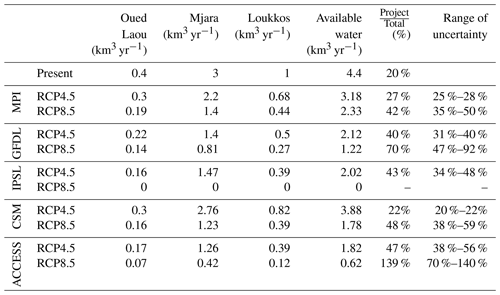
Based on the latest reports from the Moroccan High Commission for Planning (http://www.hcp.ma/, last access: 5 March 2019), a 27 % increase in demography along with an agricultural intensification, which has already lead to seriously increase water consumption (Molle and Tanouti, 2017), is expected. As a result, and assuming that current policies extend into the future, water demand will increase by 25 %.
Consequently, the project will probably turn the region into a water-scarce area. Thus, based on this analysis, the amount of water transferred should be rescaled in order to ensure that the project does not negatively impact the region. In contrast, following RCP8.5, only 27 % of the actual quantity of water is expected to be left in the region, meaning that the total available water in the region would be 1.19 km3 yr−1. If the project remains in its current form, 72 % () of the total available water in the region will be transferred. Given this result, the project becomes infeasible, as local precipitation would probably be unable to satisfy the local water demand.
Table 8Summary of runoff sensitivity to precipitation and PET under climate change using the mean of the multi-model simulations and the estimation of the future total available water in the region.
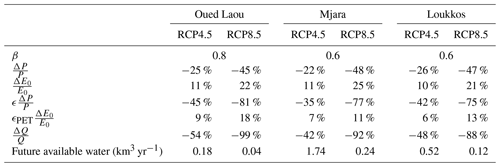
4.2.2 Using empirical formulas and RCMs
As described in Sect. 3.3, we consider the effect of climate change on runoff here. First ϵ and ϵPET are estimated using empirical formulas according to Table 4. Table 8 reports the values of ϵ and the comparison with the corresponding values from regression analysis, we remind the reader that . These results are similar to previous conclusions on sensitivity changes in runoff in arid and semiarid areas (Sankarasubramanian and Vogel, 2003). Moreover, as we compare the results of the data analysis with the empirical equations (see Table 6), the results are similar. The sensitivity of runoff to precipitation is around 1.6. In the work of Tang and Lettenmaier (2012), the authors estimate runoff sensitivity to changes in precipitation for the major global rivers worldwide. We found a good agreement between their results for this particular region and ours. According to the results reported in Table 8, the change in runoff is largely sensitive to precipitation. If we compute the sensitivity index of precipitation changes SP according to the index defined by Saltelli (2002), we find . This means that 88 % of the changes in runoff due to climate change are attributed to changes in precipitation. Ultimately, changes in PET only contribute to 12 % changes in runoff.
Following Eq. (1) and in order to fully evaluate changes in runoff due to climate change, an assessment of changes in PET is needed, as the changes in precipitation have already been discussed in a previous section. Using the Penman–Monteith equation and RCM results, we plot Fig. 10, where we show changes in PET according to RCP4.5 and RCP8.5, respectively. The watersheds of interest are shown using black contours in the map. Following RCP4.5, PET is going to increase by 11 % on average, whereas the increase will reach 22 % under RCP8.5. These results are summarized in Table 8.
Based on this analysis, we are able to say that future water availability is very likely to decrease in the region. This decrease is mainly explained by the two factors that are described in Eq. (2): (1) precipitation, which is the main water supplier in the region, will likely decrease significantly; and (2) the increase in PET will lead to an increase in the loss of available water by evapotranspiration due to the presence of significant energy at the surface, which is described by the increase in temperature in the simulations.
As a result, we are able to quantify the future potential changes in available water in the region, as reported in Table 8. Following RCP4.5, the study area will likely lose 44 % of its actual available water, meaning that the region will have a supply of only 2.44 km3 yr−1. Therefore, assuming the current scale of the project, 35 % of the total available water will be transferred. Following RCP8.5, the region is very likely to suffer water scarcity, as the supply will be dramatically reduced.
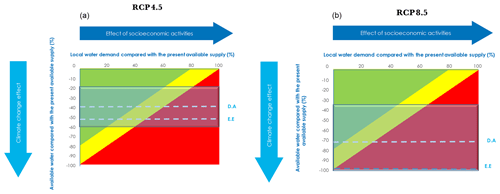
Figure 11Mapping of the vulnerability function of local water demand and supply following RCP4.5 (a) and RCP8.5 (b). The green region is where the project is feasible, the yellow region is where it should be rescaled and the red region is where it is infeasible.The shadowed regions represent the uncertainty levels. “D. A”refers to data analysis, and “E. E” refers to empirical equations.
In this study, we were not able to perform hydrological modeling due to the lack of data. In their report, RICCAR (RICCAR, 2017) were able to assess the vulnerability of water resources throughout the entire Arab region to climate change. More specifically, they used RCM results to force two hydrological models (VIC and HYPE) in order to assess changes in runoff over the Arab region. Their conclusions for the Moroccan highlands, where the sensitivity of runoff to other parameters such as vegetation have been taken into account, are similar to the findings of our research: all of the coupled climate–hydrological model simulations agree that the region is subject to a decrease in runoff due to a decrease in precipitation and an increase in temperature. Moreover, under RCP4.5, the decrease in runoff in the region ranges from −40 % to −20 %, and from −60 % to −50 % under RCP8.5. The main differences in our study come from the fact that the hydrological modeling was performed on the global scale.
4.2.3 The feasibility of the Water Highway project
Based on the previous analysis, we are able to address the problem of the viability of the Water Highway project. The project aims to transfer 0.86 km3 yr−1 from the northern watersheds considered in this analysis (Oued Laou, Loukkos and Mjara) to the southern regions. Numerical simulations have proven that the donor watersheds are going to lose a significant amount of precipitation due to global warming; therefore, water availability will also decrease. Following RCP4.5, the results based on the estimation of runoff elasticity from data analysis shows that the expected (average from the different simulations) decrease in water availability is 40 %, whereas the second study based on the empirical equations shows that the decrease could reach 44 %. As the uncertainty has also been quantified, the best-case scenario given by Table 8 is achieved when the project takes only 20 % of the total available water. In this case, the only limiting factor will be the local water demand. This is the primary reason why the feasibility of such project should be examined in a phased manner. Alternatively, the worst-case scenario shows that the project could take 56 % of the available water from the donor region. In this case, there is a clear necessity to rescale the project. Conversely, following RCP8.5, the first analysis forecasts a 73 % loss, whereas the second shows that the region would suffer from severe water scarcity with little water available in rivers. Furthermore, in the latter case the uncertainty related to analysis is considerably large. Indeed, the confidence level of the ratio of the expected water allocation for this project to the total available water in the region ranges from 35 % to 100 %. This is even more reason to advocate phased implementation of the project.
To make things worse, climate change is not the only limiting factor in the region. The northern part of Morocco has recently experienced an intensification in water-demanding activities, such as agriculture. Therefore, the feasibility of the project also depends on the amount of water allocated to satisfy local demand. Figure 11 maps the regions where the project could be feasible (green), where it needs to be rescaled (yellow) and where it is infeasible (red), according to an assumed level of water demand (computed on the basis of the present available water) and the supply given by each scenario and each method used to estimate water availability. While the vertical axis corresponds to the stress caused by climate change, the horizontal axis shows how socioeconomic activities will affect the feasibility of the project. The horizontal line in the figure, corresponding to zero on the vertical axis, represents the present state. Under the current climate, the design of the Water Highway project requires the allocation of 20 % of the total available water (). This leaves 80 % of the available water to satisfy local water demand. We also plot lines corresponding to the projected water quantities that will be lost following RCP4.5 and RCP8.5, respectively. Following the mitigation projection (RCP4.5), the northern regions are going to lose 40 % (based on data analysis study) and 44 % (based on the second analysis) of the actual available water. This means that if the project remains in its current form with 4.4 km3 yr−1 of available water, the water demand in the region should not exceed 45 % (20 % + 45 % + 35 % = 100 %) of the present available water. In contrast, if the future is driven by the business-as-usual projection (RCP8.5), the project is unlikely to be feasible, as the supply would definitely not be sufficient to satisfy local demand. Little water is likely to flow in streams, as more than 90 % of the total actual available water will likely be lost.
The north–south water transfer project (Water Highway) in Morocco aims to supply vulnerable regions in the south with water. The project will benefit from the excess water in the northern regions and will transfer 0.86 km3 yr−1 to the south. This water transfer will follow three phases, and it will include the building of two dams, several pumping stations and 500 km of pipes from the northern region southward to Al Massira Dam. The project will contribute to alleviating water stress in the south, especially supporting the sustainability of agriculture. However, despite its great potential positive impacts, the project is largely sensitive to the amount of water that will be available in the future. Therefore, its feasibility remains unclear given climate change, which is going to affect precipitation over Morocco in general. Regional climate models (RCMs) agree in predicting that the future will bring less water; however, there is significant uncertainty regarding the quantity of water that will be lost. There are several reasons behind this uncertainty in the simulation results; boundary conditions given by GCMs (global circulation models) are main contributors to the uncertainty. Furthermore, the future simulations are also driven by different greenhouse gas emission scenarios, which lead to different climate projections. In the present study, we used two projections: RCP4.5 (with mitigation) and RCP8.5 (business as usual). Following each of the aforementioned scenarios, the precipitation will decrease in the northern water basins. Following RCP4.5, the decrease is expected to be between −33 % and −10 %. In comparison, following RCP8.5, the decrease is expected to be in the range between −70 % and −34 %.
In order to assess the water quantities that will be lost, we used two different approaches: data analysis and sensitivity analysis using empirical equations. In the first approach, we computed the runoff elasticity coefficients based on field observations. Overall this analysis shows that a 10 % change in precipitation will lead to a 16 % change in runoff. Compared with the results of the expected decrease in precipitation, the elasticity analysis indicates that runoff is going to be even more sensitive to climate change. In the second approach, we assessed the sensitivity of runoff to climate change using different empirical relationships. The conclusions are similar to previous results. We found that changes in runoff are mainly driven by the decrease in precipitation. Furthermore, we estimated that the potential amount of loss following RCP4.5 will result in runoff decreasing by 44 %; however, under RCP8.5, a very little water is likely to flow in rivers, as more than 90% of the total available water is likely to be lost.
Finally, we have developed a map of vulnerability given each climate simulation and the future local water demand. This analysis helps to assess the viability of the project based on assumed water demand in the donor watersheds. Under RCP8.5, the project is likely unfeasible. However, under RCP4.5, a rescaled version of this project may be feasible depending on the level of local water demand that is assumed. Our results generally agree with the conclusions of Greve et al. (2018), who discussed the issue on a global scale. Given the uncertainties introduced by climate change and reported in this study, the water transfer project, as an example of water resource planning, needs to be carried out carefully and implemented in a phased manner.
Based on this work, there are several questions that still need to be addressed. First, given the large uncertainties in the climate model simulation results and the climate scenarios, further research is needed to assess the uncertainty. Second, given the complex hydrological behavior of the watersheds, there is a need to perform hydrological modeling in order to more accurately assess how climate change will affect runoff. Finally, in order to address a global critical analysis of the feasibility of the project, the future local water demand driven by the expected population growth and the future water-demanding activities should be quantified.
The data used in this study were provided by the ABH. We are unable to made them publicly available; however, the data can be made available upon request (Nabil El Moçayd, nabil.elmocayd@um6p.ma).
SK performed the MRCM numerical simulations, NEM analyzed the data, and EABE designed the study. The three authors contributed equally to writing the paper.
The authors declare that they have no conflict of interest.
This work was undertaken in the framework of the UMRP project with financial support from OCP. We are grateful to Alexandre Tuel, Catherine Nikiel, Timothy Adams and the rest of the Eltahir Research Group for their helpful comments. The authors would like to thank Abdellah Bourak from ABH Sebou for his help with data acquisition. We would also like to acknowledge Abdelouahed El Kouri, Rachid Chahri and Salah Eddine Dahbi from ABH Loukkos for their help and beneficial discussions. Finally, we gratefully acknowledge comments and suggestions from the anonymous reviewers and the editor.
This research was undertaken within the framework of UMRP with financial support from OCP.
This paper was edited by Pieter van der Zaag and reviewed by two anonymous referees.
Alter, R. E., Im, E.-S., and Eltahir, E. A.: Rainfall consistently enhanced around the Gezira Scheme in East Africa due to irrigation, Nat. Geosci., 8, 763–767, 2015. a
Arora, V. K.: The use of the aridity index to assess climate change effect on annual runoff, J. Hydrol., 265, 164–177, https://doi.org/10.1016/S0022-1694(02)00101-4, 2002. a, b
Batisani, N. and Yarnal, B.: Rainfall variability and trends in semi-arid Botswana: implications for climate change adaptation policy, Appl. Geogr., 30, 483–489, 2010. a
Berkoff, J.: China: the South–North water transfer project – is it justified?, Water Policy, 5, 1–28, 2003. a
Bi, D., Dix, M., Marsland, S. J., O'Farrell, S., Rashid, H., Uotila, P., Hirst, A., Kowalczyk, E., Golebiewski, M., Sullivan, A., Yan, H., Hannah, N., Franklin, C., Sun, Z., Vohralik, P., Watterson, I., Zhou, X., Fiedler, R., Collier, M., Ma, Y., Noonan, J., Stevens, L., Uhe, P., Zhu, H., Griffies, S. M., Hill, R., Harris, C., and Puri, K.: The ACCESS coupled model: description, control climate and evaluation, Aust. Meteorol. Oceanogr. J., 63, 41–64, 2013. a
Boke-Olén, N., Abdi, A. M., Hall, O., and Lehsten, V.: High-resolution African population projections from radiative forcing and socio-economic models, 2000 to 2100, Scient. Data, 4, 160130, https://doi.org/10.1038/sdata.2016.130, 2017. a
Born, K., Christoph, M., Fink, A., Knippertz, P., Paeth, H., and Speth, P.: Moroccan climate in the present and future: combined view from observational data and regional climate scenarios, Climatic changes and water resources in the Middle East and North Africa, Springer, Berlin, Heidelberg, 29–45, 2008. a
Déqué, M., Rowell, D., Lüthi, D., Giorgi, F., Christensen, J., Rockel, B., Jacob, D., Kjellström, E., De Castro, M., and van den Hurk, B.: An intercomparison of regional climate simulations for Europe: assessing uncertainties in model projections, Climatic Change, 81, 53–70, 2007. a
Döll, P.: Vulnerability to the impact of climate change on renewable groundwater resources: a global-scale assessment, Environ. Res. Lett., 4, 035006, https://doi.org/10.1088/1748-9326/4/3/035006, 2009. a
Dooge, J., Bruen, M., and Parmentier, B.: A simple model for estimating the sensitivity of runoff to long-term changes in precipitation without a change in vegetation, Adv. Water Resour., 23, 153–163, https://doi.org/10.1016/S0309-1708(99)00019-6, 1999. a
Doukkali, M.: Water institutional reforms in Morocco, Water Policy, 7, 71–88, 2005. a
Driouech, F., Déqué, M., and Sánchez-Gómez, E.: Weather regimes Moroccan precipitation link in a regional climate change simulation, Global Planet. Change, 72, 1–10, https://doi.org/10.1016/j.gloplacha.2010.03.004, 2010. a
Droogers, P., Immerzeel, W. W., Terink, W., Hoogeveen, J., Bierkens, M. F. P., van Beek, L. P. H., and Debele, B.: Water resources trends in Middle East and North Africa towards 2050, Hydrol. Earth Syst. Sci., 16, 3101–3114, https://doi.org/10.5194/hess-16-3101-2012, 2012. a
Dufresne, J.-L., Foujols, M.-A., Denvil, S., Caubel, A., Marti, O., Aumont, O., Balkanski, Y., Bekki, S., Bellenger, H., Benshila, R., Bony, S., Bopp, L., Braconnot, P., Brockmann, P., Cadule, P., Cheruy, F., Codron, F., Cozic, A., Cugnet, D., de Noblet, N., Duvel, J.-P., Ethé, C., Fairhead, L., Fichefet, T., Flavoni, S., Friedlingstein, P., Grandpeix, J.-Y., Guez, L., Guilyardi, E., Hauglustaine, D., Hourdin, F., Idelkadi, A., Ghattas, J., Joussaume, S., Kageyama, M., Krinner, G., Labetoulle, S., Lahellec, A., Lefebvre, M.-P., Lefevre, F., Levy, C., Li, Z. X., Lloyd, J., Lott, F., Madec, G., Mancip, M., Marchand, M., Masson, S., Meurdesoif, Y., Mignot, J., Musat, I., Parouty, S., Polcher, J., Rio, C., Schulz, M., Swingedouw, D., Szopa, S., Talandier, C., Terray, P., Viovy, N., and Vuichard, N.: Climate change projections using the IPSL-CM5 Earth System Model: from CMIP3 to CMIP5, Clim. Dynam., 40, 2123–2165, 2013. a
Dunne, J. P., John, J. G., Adcroft, A. J., Griffies, S. M., Hallberg, R. W., Shevliakova, E., Stouffer, R. J., Cooke, W., Dunne, K. A., Harrison, M. J., Krasting, J. P., Malyshev, S. L., Milly, P. C. D., Phillipps, P. J., Sentman, L. T., Samuels, B. L., Spelman, M. J., Winton, M., Wittenberg, A. T., and Zadeh, N.: GFDL's ESM2 global coupled climate–carbon earth system models. Part I: Physical formulation and baseline simulation characteristics, J. Climate, 25, 6646–6665, 2012. a
Eltahir, E. A., Winter, J. M., Marcella, M. P., Gianotti, R. L., and Im, E.-S.: Introducing the MIT Regional Climate Model (MRCM), in: vol. 15, EGU General Assembly 2013, 7–12 April 2013, Vienna, Austria, EGU2013-4124, 2013. a
Feng, S., Li, L. X., Duan, Z. G., and Zhang, J. L.: Assessing the impacts of South-to-North Water Transfer Project with decision support systems, Decis. Support Syst., 42, 1989–2003, 2007. a
Filahi, S., Tramblay, Y., Mouhir, L., and Diaconescu, E. P.: Projected changes in temperature and precipitation indices in Morocco from high-resolution regional climate models, Int. J. Climatol., 37, 4846–4863, 2017. a
Gent, P. R., Danabasoglu, G., Donner, L. J., Holland, M. M., Hunke, E. C., Jayne, S. R., Lawrence, D. M., Neale, R. B., Rasch, P. J., Vertenstein, M., Worley, P. H., Yang, Z.-L., and Zhang, M.: The community climate system model version 4, J. Climate, 24, 4973–4991, 2011. a
Giorgetta, M. A., Jungclaus, J., Reick, C. H., Legutke, S., Bader, J., Böttinger, M., Brovkin, V., Crueger, T., Esch, M., Fieg, K., Glushak, K., Gayler, V., Haak, H., Hollweg, H.-D., Ilyina, T., Kinne, S., Kornblueh, L., Matei, D., Mauritsen, T., Mikolajewicz, U.,Mueller, W., Notz, D., Pithan, F., Raddatz, T., Rast, S., Redler, R., Roeckner, E., Schmidt, H., Schnur, R., Segschneider, J., Six, K. D., Stockhause, M., Timmreck, C., Wegner, J., Widmann, H., Wieners, K.-H., Claussen, M., Marotzke, J., and Stevens, B.: Climate and carbon cycle changes from 1850 to 2100 in MPI-ESM simulations for the Coupled Model Intercomparison Project phase 5, J. Adv. Model. Earth Syst., 5, 572–597, 2013. a
Giorgi, F. and Lionello, P.: Climate change projections for the Mediterranean region, Global Planet. Change, 63, 90–104, 2008. a
Greve, P., Kahil, T., Mochizuki, J., Schinko, T., Satoh, Y., Burek, P., Fischer, G., Tramberend, S., Burtscher, R., Langan, S., and Wada, Y.: Global assessment of water challenges under uncertainty in water scarcity projections, Nat. Sustainabil., 1, 486–494, 2018. a, b, c
Gu, W., Shao, D., and Jiang, Y.: Risk evaluation of water shortage in source area of middle route project for South-to-North Water Transfer in China, Water Resour. Manage., 26, 3479–3493, 2012. a
Hellegers, P., Immerzeel, W., and Droogers, P.: Economic concepts to address future water supply – demand imbalances in Iran, Morocco and Saudi Arabia, J. Hydrol., 502, 62–67, 2013. a
Huffman, G. J. and Bolvin, D. T.: TRMM and other data precipitation data set documentation, in: Vol. 28, NASA, Greenbelt, USA, 1–45, 2013. a, b
Im, E.-S., Gianotti, R. L., and Eltahir, E. A.: Improving the simulation of the West African Monsoon using the MIT regional climate model, J. Climate, 27, 2209–2229, 2014a. a
Im, E.-S., Marcella, M. P., and Eltahir, E. A.: Impact of potential large-scale irrigation on the West African monsoon and its dependence on location of irrigated area, J. Climate, 27, 994–1009, 2014b. a
Kahil, M. T., Dinar, A., and Albiac, J.: Modeling water scarcity and droughts for policy adaptation to climate change in arid and semiarid regions, J. Hydrol., 522, 95–109, https://doi.org/10.1016/j.jhydrol.2014.12.042, 2015. a
Kang, S., Tuel, A., and Eltahir, E. A.: High Resolution Climate Change Projections over Northwest Africa, in review, 2020. a, b, c
Li, L., Zhang, L., Xia, J., Gippel, C. J., Wang, R., and Zeng, S.: Implications of modelled climate and land cover changes on runoff in the middle route of the south to north water transfer project in China, Water Resour. Manage., 29, 2563–2579, 2015. a
Lioubimtseva, E. and Henebry, G. M.: Climate and environmental change in arid Central Asia: Impacts, vulnerability, and adaptations, J. Arid Environ., 73, 963–977, 2009. a
Liu, C. and Zheng, H.: South-to-north water transfer schemes for China, Int. J. Water Resour. Dev., 18, 453–471, 2002. a
Marchane, A., Tramblay, Y., Hanich, L., Ruelland, D., and Jarlan, L.: Climate change impacts on surface water resources in the Rheraya catchment (High Atlas, Morocco), Hydrolog. Sci. J., 62, 979–995, 2017. a
Minoia, P. and Brusarosco, A.: Water infrastructures facing sustainable development challenges: Integrated evaluation of impacts of dams on regional development in Morocco, https://doi.org/10.22004/ag.econ.12141, 2006. a
Molle, F. and Tanouti, O.: Squaring the circle: Agricultural intensification vs. water conservation in Morocco, Agr. Water Manage., 192, 170–179, 2017. a
Monteith, J. L.: Evaporation and environment, Symp. Soc. Exp. Biol., 19, 205–234, 1965. a
Moradkhani, H., Hsu, K.-L., Gupta, H., and Sorooshian, S.: Uncertainty assessment of hydrologic model states and parameters: Sequential data assimilation using the particle filter, Water Resour. Res., 41, W05012, https://doi.org/10.1029/2004WR003604, 2005. a
Niemann, J. D. and Eltahir, E. A.: Prediction of regional water balance components based on climate, soil, and vegetation parameters, with application to the Illinois River Basin, Water Resour. Res., 40, W03103, https://doi.org/10.1029/2003WR002806, 2004. a
Niemann, J. D. and Eltahir, E. A.: Sensitivity of regional hydrology to climate changes, with application to the Illinois River basin, Water Resour. Res., 41, W07014, https://doi.org/10.1029/2004WR003893, 2005. a, b
Ol'Dekop, E.: On evaporation from the surface of river basins, T. Meteorol. Observ., 4, 200, 1911. a, b
Pal, J. S., Giorgi, F., Bi, X., Elguindi, N., Solmon, F., Gao, X., Rauscher, S. A., Francisco, R., Zakey, A., Winter, J., Ashfaq, M., Syed, F. S., Bell, J. L., Diffenbaugh, N. S., Karmacharya, J., Konaré, A., Martinez, D., da Rocha, R. P., Sloan, L. C., and Steiner, A. L.: Regional climate modeling for the developing world: the ICTP RegCM3 and RegCNET, B. Am. Meteorol. Soc., 88, 1395–1410, 2007. a
Patricola, C. M. and Cook, K. H.: Northern African climate at the end of the twenty-first century: an integrated application of regional and global climate models, Clim. Dynam., 35, 193–212, 2010. a, b
Pike, J.: The estimation of annual run-off from meteorological data in a tropical climate, J. Hydrol., 2, 116–123, 1964. a, b
Reichle, R. H., McLaughlin, D. B., and Entekhabi, D.: Hydrologic data assimilation with the ensemble Kalman filter, Mon. Weather Rev., 130, 103–114, 2002. a
RICCAR: Arab Climate Change Assessment Report, Tech. rep., The Regional Initiative for the Assessment of Climate Change Impacts on Water Resources and Socio-economic Vulnerability in the Arab Region, available at: https://www.unescwa.org/publications/riccar-arab-climate-change-assessment-report (last access: March 2020), 2017. a
Risbey, J. S. and Entekhabi, D.: Observed Sacramento Basin streamflow response to precipitation and temperature changes and its relevance to climate impact studies, J. Hydrol., 184, 209–223, 1996. a
Saltelli, A.: Making best use of model evaluations to compute sensitivity indices, Comput. Phys. Commun., 145, 280–297, 2002. a
Sankarasubramanian, A. and Vogel, R. M.: Hydroclimatology of the continental United States, Geophys. Res. Lett., 30, 1363, https://doi.org/10.1029/2002GL015937, 2003. a, b
Sankarasubramanian, A., Vogel, R. M., and Limbrunner, J. F.: Climate elasticity of streamflow in the United States, Water Resour. Res., 37, 1771–1781, 2001. a, b
Schilling, J., Freier, K. P., Hertig, E., and Scheffran, J.: Climate change, vulnerability and adaptation in North Africa with focus on Morocco, Agr. Ecosyst. Environ., 156, 12–26, 2012. a
Schreiber, P.: Über die Beziehungen zwischen dem Niederschlag und der Wasserführung der Flüsse in Mitteleuropa, Z. Meteorol., 21, 441–452, 1904. a, b
Sowers, J., Vengosh, A., and Weinthal, E.: Climate change, water resources, and the politics of adaptation in the Middle East and North Africa, Climatic Change, 104, 599–627, 2011. a
Tang, C., Yi, Y., Yang, Z., and Cheng, X.: Water pollution risk simulation and prediction in the main canal of the South-to-North Water Transfer Project, J. Hydrol., 519, 2111–2120, 2014. a
Tang, Q. and Lettenmaier, D. P.: 21st century runoff sensitivities of major global river basins, Geophys. Res. Lett., 39, L06403, https://doi.org/10.1029/2011GL050834, 2012. a, b
Tebaldi, C. and Knutti, R.: The use of the multi-model ensemble in probabilistic climate projections, Philos. T. Roy. Soc. A, 365, 2053–2075, 2007. a
Thornthwaite, C. W. and Mather, J. R.: Instructions and tables for computing potential evapotranspiration and the water balance, Tech. rep., Laboratory of Climatology, Drexel Institute of Technology, Centerton, NJ, 1957. a
Tramblay, Y., Ruelland, D., Somot, S., Bouaicha, R., and Servat, E.: High-resolution Med-CORDEX regional climate model simulations for hydrological impact studies: a first evaluation of the ALADIN-Climate model in Morocco, Hydrol. Earth Syst. Sci., 17, 3721–3739, https://doi.org/10.5194/hess-17-3721-2013, 2013. a, b
Tramblay, Y., Jarlan, L., Hanich, L., and Somot, S.: Future scenarios of surface water resources availability in North African dams, Water Resour. Manage., 32, 1291–1306, 2018. a
Turc, L.: Le bilan d'eau des sols: relations entre les précipitations, l'évaporation et l'écoulement, PhD thesis, Université de Paris, Institut national de la recherche agronomique, Paris, 1953. a, b
Vizy, E. K. and Cook, K. H.: Mid-Twenty-First-Century Changes in Extreme Events over Northern and Tropical Africa, J. Climate, 25, 5748–5767, https://doi.org/10.1175/JCLI-D-11-00693.1, 2012. a
Vörösmarty, C. J., Green, P., Salisbury, J., and Lammers, R. B.: Global Water Resources: Vulnerability from Climate Change and Population Growth, Science, 289, 284–288, https://doi.org/10.1126/science.289.5477.284, 2000. a
Wada, Y., Gleeson, T., and Esnault, L.: Wedge approach to water stress, Nat. Geosci., 7, 615–617, 2014. a
Ward, F. A. and Pulido-Velazquez, M.: Water conservation in irrigation can increase water use, P. Natl. Acad. Sci. USA, 105, 18215–18220, https://doi.org/10.1073/pnas.0805554105, 2008. a
Water-Office: Performance budget for 2018, Tech. rep., State Secretariat to the Minister of Equipment, Transport, Logistics and water-Water Officer, Rabat, Morocco, 2017. a, b
Wei, S., Yang, H., Abbaspour, K., Mousavi, J., and Gnauck, A.: Game theory based models to analyze water conflicts in the Middle Route of the South-to-North Water Transfer Project in China, Water Res., 44, 2499–2516, 2010. a
Yang, H. and Yang, D.: Derivation of climate elasticity of runoff to assess the effects of climate change on annual runoff, Water Resour. Res., 47, W07526, https://doi.org/10.1029/2010WR009287, 2011. a, b, c, d
Yang, H. and Zehnder, A. J.: The south-north water transfer project in China: An analysis of water demand uncertainty and environmental objectives in decision making, Water Int., 30, 339–349, 2005. a
Yang, Q., Ma, Z., Zheng, Z., and Duan, Y.: Sensitivity of potential evapotranspiration estimation to the Thornthwaite and Penman–Monteith methods in the study of global drylands, Adv. Atmos. Sci., 34, 1381–1394, 2017. a
Zhang, L., Dawes, W., and Walker, G.: Response of mean annual evapotranspiration to vegetation changes at catchment scale, Water Resour. Res., 37, 701–708, 2001. a
Zhang, Q.: The South-to-North Water Transfer Project of China: Environmental Implications and Monitoring Strategy, J. Am. Water Resour. Assoc., 45, 1238–1247, 2009. a, b
Zhang, Q., Xu, Z., Shen, Z., Li, S., and Wang, S.: The Han River watershed management initiative for the South-to-North water transfer project (Middle Route) of China, Environ. Monit. Assess., 148, 369–377, 2009. a






